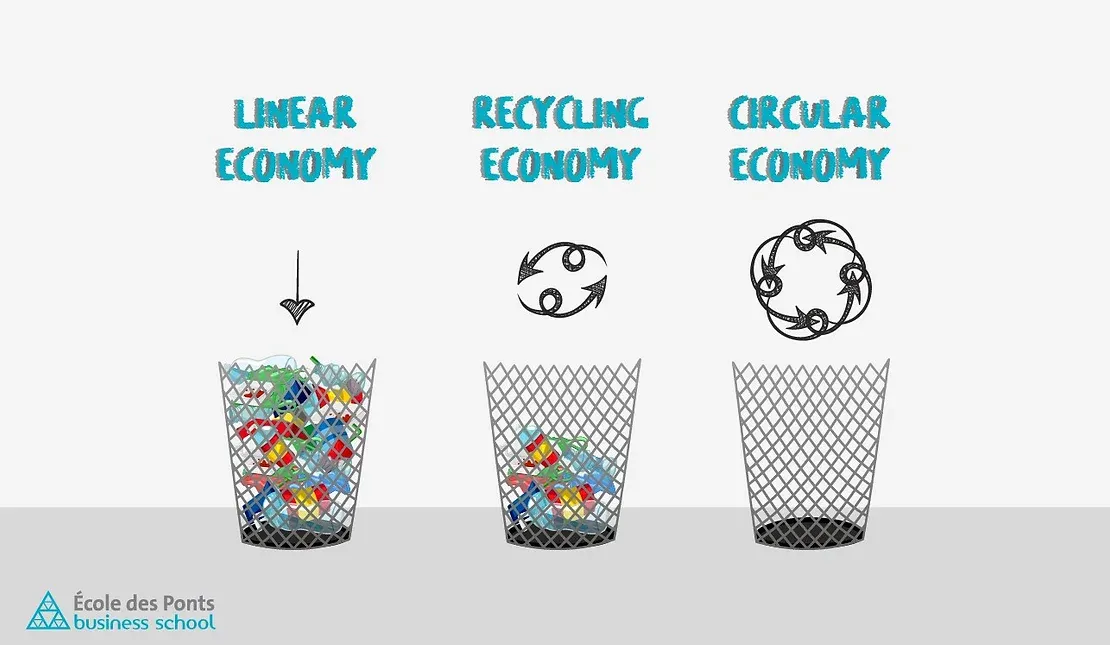The Circular Economy
The notion of a circular economy and its relevance to approaches to management in the future.

Introduction
Our current economic model is, in most part, a linear one. It has increased incrementally as demand has increased over time. If we continue to follow this model into the future we would eventually run out of virgin materials and, whether it be landfill, air or sea pollution, we will destroy our planet even further. This exploitative model has been around for centuries, with the industrial revolution accelerating dramatically the use of raw materials. This has continued to grow at pace globally as developing countries have also industrialised. Pursuit of growth has been the single most important policy goal across the world but as the economy expands, so do the resource implications associated with it[1].
The way in which our society works, which is embedded into most of our subconscious buying decisions, is that we desire cheaper, faster, increased choice and greater availability. Individuals, even with greatest exposure to higher education, will still resort to personal ease and benefit when making a choice on what to buy, with little regard to the long-term consequences. There was a climate shock with the discovery of a hole in the ozone layer back in May 1985[2]. An estimated 60% of the world’s ecosystems have been degraded. Global carbon emissions have risen by 40% since 1990 (the Kyoto Protocol ‘base year’)[3]. Since then there have been some marginal changes over the last few decades, with an increase in publicity around recycling and a small increase in demand for organic and fair-trade products. These events show there is some faith in the nature of humanity to change to a more sustainable lifestyle. We are in an age of irresponsibility; we are overlooking sustainability with the link to ecological, social and psychological[4] issues.
The importance of this matter only shows how we live and manage in a highly materialistic world, oblivious, potentially out of choice, to the social, environmental and economic impacts we are creating. There remains the possibility that continued economic growth is a necessary condition for a lasting prosperity. Evidence leads to an uncomfortable and deep-seated dilemma: growth may be unsustainable, but ‘de-growth’ appears to be unstable[5].
This continued destruction of our planet has finally brought about a different way of thinking, allowing the development of a new economic model, aiming for long-term sustainability, called the Circular Economy (CE)[6] that managers will have to implement.
To reiterate what we already know, the CE would stop the pillaging of our planet and if it were possible to introduce on a global scale, we would massively extend the time resources were available, massively reduce pollution by recycling and reusing, and create a much better environment for the generations to come. The predictions for the creation of new job spaces within the model is reassuring and the contribution to the economy would eventually be positive, therefore reaching a more sustainable way of business. Mckinsey estimates shifting towards circularity could add $1 trillion to the global economy by 2025 and create 100,00 new jobs within the next fiver years[7].
In the CE a large topical debate is to reduce, reuse and recycle. If you are a growing company, in theory, you will need more materials. How can these expanding businesses adhere to this monumental shift in models? In many cases the use of the correct materials to enable recycling and reuse will increase cost, sometimes, quite dramatically. This will also apply to manufacturing techniques, when keeping materials separate for the ease of recycling. Not only do we focus on the raw materials in this assessment but the systems and processes behind them. Reduction of energy use in the production side of business is also a key issue to address, but here again is an example of an expensive change, when having to invest in new machinery or the use of renewable energy. The highest barrier this CE model faces is the resistance to change. This comes not only from the business side, but also on the individual and social level, which encompasses the shift in consumer patterns. The most interesting debate of implementing the CE model is between cost and sustainability; will we need to reach fearful levels of global demolition to encourage a better way of living? Decoupling is our answer[8].
Implementation
Regulation
This is potentially the most fundamental area of extreme significance as legislation and regulations are the guidelines by which society lives, and the economy runs. A massive shift in legislation will cause an upheaval in the business world, but it’s a necessity to change the way in which we live.
CE is important for the economy but also should be the structure for the government to help create jobs. Rather than an industry failing and jobs lost, i.e. the last recession in 2008, there will be recreation of jobs in new sectors such as the increase in recycling, and technical areas, such as locating wasted materials and transferring them to a more profitable place, i.e. from a landfill to another nation in desperate need of metals for construction for houses. Think of all our waste and how much others could profit from it. Companies have benefited from offering active recycling schemes, such as the mobile phone industry, that reclaim used mobile phones. Governments could also specify CE products and services (when they are the customer), such as for defence, NHS, and road and rail purchasing.
Persuading Multi National Corporations will be hard, as they are driven exclusively by short-term profits. They also rely heavily on global imports and exports and therefore have a massive impact on the wastefulness of the economy. A potential new strategy for regulation could implement the importance for existing companies and start ups, for example, to all have to abide by the model and perhaps pay an extra ‘green’ tax – the more waste you produce the more you pay. This happens now in the UK where there is a landfill tax levied on waste. This creates incentive to do well and the government could offer pay-outs for the best performing firms. People would be more aware of the issue as they see they are paying an extra ‘tax’ on products and can therefore distinguish between competitors. The initiative would aspire to enable its participants to realise the rewards of becoming first-movers: capturing the value of the circular economy[9]
Funding
An implementation technique could be consumer-funding, suggesting that ‘I will give you benefits if you keep your product longer’. Manufacturers could also use the ‘carrot and stick’ scenario, by creating temptation through funding you, and then supporting you through the product lifespan. The ‘stick’ then, could be legislation.
Low cost loans could be made available to start the process, and for R&D into renewable energy. This would need funding, as the returns on renewables are slow. By ramping up renewable energy, we can:
· Reduce air pollution
· Cut global warming emissions
· Create new jobs and industries
· Diversify our power supply
· Decrease dependence on coal and other fossil fuels[10]
A lot of investments will be required to make the decoupling possibilities and, hence, a more sustainable economic structure, come true. The investments needed to make it possible for the various sectors and subsectors to become increasingly decoupled will temporarily, during the transition phase, increase economic activity, employment and emissions[11].
Supply chain
One of the strongest motivators is the scarcity of certain raw materials, which would render some products manufactured today obsolete. The elements of the supply chain that will need to change; for example, if you were a provider of raw materials and commodities you may find there is no future. If you mine iron-ore today, in the CE future, it may be exclusively recycled steel that is used across the board, therefore either you change to become a recycler of steel or you are out of business. There has been a significant improvement in the new economy, known as the Sharing Economy, thanks to the boom of technology. Consumers and organisations are now sharing resources and information reducing the amount of usage of materials, businesses such as AirB&B and UBER are prime examples of this.
Probably the single most important element in implementing the CE model, is product design and material specification. For the CE to work, the way in which products are assembled has an enormous effect on how they can be recycled. As well as incorporating recyclability, the design process needs to create products and services where demand stays high. There is no point in creating a totally recyclable product, which is undesirable to the consumer. Organisations must think of the manufacturing or service process in order to use less, by reducing the use of virgin materials and energy in the process and reducing transport costs by sourcing locally. This makes the process more efficient as it shows how a circular model can operate, not only in the individual firm, but also on a global scale.
If you regard the new formation of the supply chain as a circle itself, then ideally the company could profit from recycling their own product. What the consumer would naturally disregard as a used or old product could create beneficial supplies for the company. Rather than the company outsourcing for each line of production, they could reuse their own products thus ensuring all can profit from the ‘waste not, want not’ scenario. This shows how dematerialisation can aid the economy, and potentially reduces supply chain anxieties, by diminishing demand for outsourced materials. Business leaders can capture commercial value across supply chains by using closed material loops and regenerating material assets[12]. The challenge here is how can we secure the materials at the end of the products life? There will be difficulties, however, the new economic shape could allow a space for job creation, adding an extra node on the network line between landfills and the original companies. By trying to reduce the complexity of supply chains, management can increase communication and encourage localisation for more efficient production and services.
Transparency
The greatest challenge facing the CE model is consumer demand. Without getting consumers on board, the only driver for the CE will be when natural resources are completely depleted. To avoid this catastrophic state, consumers need to be convinced that any extra cost, or in some cases, lack of functionality, feeds the greater good of the CE and the planet. There will be major challenges in changing consumer behaviour to not always require better, newer, faster. It is not necessary to update your mobile or replace your car every few years, which is the way in which we are taught. For the model to really work, consumer education will be extremely vital and a major challenge. Many consumers do not see our current system as cracked or even if they are aware of some noise in this area, the materialistic consumerism will override any moral decision. This is seen presently in current social behaviours, such as obesity, smoking and drinking - all areas that damage us and yet we continue. If people cannot do it on a personal level, how can we do it in the general economy? In order to put across the new innovative message about the model, complete transparency in all areas of business, especially energy and material use, is required.
It is likely that legislation will be required in various industries, as most companies will not naturally wish to expose their CE credentials if they are underperforming. To make a change, you need everyone to be on board and fully committed - this requires full transparency.
Adopting this moral position into the DNA of the business, making it a way of life rather than a box ticking quota issue. For example hiring women in business or someone of different ethnicity for a correct status quo. Management is more likely to achieve this position by taking into account social, political and ecological factors and by modifying their current behaviour patterns that are motivated by, often immoral, personal and corporate gains. Now, in the hyper-connected, and ever evolving world, transparency is the new power[13].
Education
Where does it all start when employing the model and greener way of thinking? What is most needed is support that enables learners to develop a clear sense of the narrative of a putative circular economy, its coherence, and what this implies for, say, teaching and learning methodologies[14]. It starts with the awareness and knowledge of our current situation, stemming from education. Educating from a young age, from early school years, and also changing the perspectives of the older generation, our current managers. The war on waste is a key topic, not just the idea of recycling and reusing, but the facts on how finite our resources actually are, how to use more efficient energy sources, how to redesign harmful products, how to effectively manage time and, overall, how to reduce the costs for the organisation and the environment. Society needs to be educated to change the way businesses operate and the way consumers think. If the message were more ingeniously put across to consumers, their awareness would increase. Currently, generations are told that they need to do whatever it takes to excel and product marketing makes us constantly desire more. Although there is an innate instinct in the human race to always desire more, we could be happier with less, and marketing messages are wrongly educating us into thinking differently. With developed learning on renewable energy, managers can create funds from dematerialising, therefore leading to energy saving and material savings to invest in sustainable engineering development. We need extra education on our ecosystems and the damage we are doing to the biosphere; effectively destroying ourselves.
Management & The Future
Changing the future is actually relatively easy, as education can train the management of the future to the new way of thinking. The easy part is the introduction to the curriculum. The difficult part is changing the thought processes of the old-fashioned business entrepreneurs and professional managers. With existing and entrenched management would they have the capability of implementing CE? Of course, it’s another system and process, which would use their current skills and strengths. The hurdle is to win their hearts and souls for the CE concept and it is this that will actually make a difference.
Managers control companies but when you get to a larger scale, there will rarely be a sole owner. In the majority of cases, companies are listed and owned through ‘us’ - through our pensions and savings. First, the owners (us) have to accept longer-term returns and move away from instant short-term gains. We then need to insist that our managers adopt CE principles. As consumers, we think of ourselves as victims of decisions made by larger corporations but in reality we are often the owners of these businesses. We therefore not only have influence via consumer demand but also as shareholders to influence future management.
Currently managers tend to be judged on short-term gain and profitability. If you examine the key performance indicators of virtually every company, they are obsessed with quantity, how fast and how profitable. This reflects how management currently works across the economy; you could envisage a set of KPI’s of a CE company, which would relate to percentage recyclable, energy usage, reduction of toxins, use of virgin materials.
‘Decoupling’, the continued economic growth with continually declining material quantity[15], is critical for CE success. Managers can decide between, or include both:
• Relative: decline in the ecological intensity per unit of economic output or[16]
• Absolute: Resource efficiencies must increase at least as fast as economic output does and must continue to improve as the economy grows[17]
The new green CE deal, which managers need to abide by, is a long-term project portraying benefits throughout its timeline:
• Short term - offers jobs and economic recovery[18]
• Medium term - energy security and technological innovation[19]
• Long term - sustainable future for our children[20]
Managers should understand the demand of ecological modernism, a new manifesto calling for a “good Anthropocene.” They write: “A good Anthropocene demands that humans use their growing social, economic, and technological powers to make life better for people, stabilise the climate, and protect the natural world.” [21] Managers should be directing capitalistic approaches to include all aspects to reach a steady state economy[22].
Conclusion
We have discussed the Circular Economy, and the fact that eventually we have no choice but to adopt it. A lack of resources and pollution inevitably lead to CE as the only answer, unless humanity can accept extinction. Radical sustainability is not only good for the environment, but it pays ecologically as well. We have no choice but to use this model as a way of life as we are a key part of the environment. Therefore we should be using this model for our own livelihood and, even survival, something that our society seems to overlook.
Management, therefore, has to learn how to implement and maintain a successful CE model, and use it as a new way to compete in the economy. Driving changes from short term visions to long term visions. People are selfish in business and if they find an innovative idea and guard it fiercely. This shouldn’t be the case for the CE model, this is not just an innovative idea, it should be a way of life.
The primary driver will be education, starting in schools, where it should be an important part of the statutory curriculum, and carried on through into colleges and universities. CE needs to be built into design, manufacturing processes, recycling, product longevity and be facilitated by government regulation and funding initiatives. There will not be a one-model-fits-all situation across different sectors, but the CE model allows mobility to be doing the best one can, given their circumstances. How managers can transition the economy to a more steady state model is to build a sustainable macro-economy, protect capabilities for flourishing and respect ecological limits[23]. The biggest challenge however is to create consumer pull. It is us, the consumers, who will ultimately help create the change.
References
Daly, Herman. 1991. Steady-State Economics. Island Press, Washington, DC. 286pp
Herzberg, Benjamin. "Introducing Open Supply Chain Platform". World Bank Presentation to the Sedex Global Responsible Sourcing Conference (2014): n. pag. Print.
Jackson, Professor Tim. "Prosperity Without Growth? The Transition To A Sustainable Economy".Sustainable Development Commission (2009): n. pag. Print.
Lang, Christian. "Supply Management Magazine". Tradeshift (2016): n. pag. Print.
Lind, Michael. "The Case For Ecomodernism". The Smart Set. N.p., 2015. Web. 9 May 2016.
MacArthur, Ellen. "CIRCULAR ECONOMY AND CURRICULUM DEVELOPMENT IN HIGHER EDUCATION". Ellen MacArthur Foundation (2015): n. pag. Print.
MacArthur, Ellen. "Towards The Circular Economy, Accelerating The Scale-Up Across Global Supply Chains". World Economic Forum and McKinsey & Company (2013): n. pag. Print.
MacArthur, Ellen. "Towards The Circular Economy: Accelerating The Scale-Up Across Global Supply Chains". World Economic Forum, Geneva, Switzerland, Ellen MacArthur Foundation and McKinsey & Company (2014): n. pag. Print.
Simonis, Udo E. "Decoupling Natural Resource Use And Environmental Impacts From Economic Growth20131marina Fischer‐Kowalski, Mark Swilling Et Al.. Decoupling Natural Resource Use And Environmental Impacts From Economic Growth . Geneva: United Nations Environment Programme (UNEP) 2011. Xviii+152 Pp., ISBN: 978‐92‐807‐3167‐5". International Journal of Social Economics 40.4 (2013): 385-386. Web.
"Smart Energy Solutions: Increase Renewable Energy". Union of Concerned Scientists. N.p., 2016. Web. 9 May 2016.
"The Ozone Layer". British Antarctic Survery (2015): n. pag. Web. 7 May 2016.
Wijkman, Anders and Kristian Skånberg. "The Circular Economy And Benefits For Society, Jobs And Climate Clear Winners In An Economy Based On Renewable Energy And Resource Efficiency".Club Of Rome n. pag. Print.
[1] Jackson, 2009
[2] British Antarctic Survey, 2015
[3] Jackson, 2009
[4] Jackson, 2009
[5] Jackson, 2009
[6] The ’circular economy’ is an industrial system that is restorative by intention and design. The
idea is that rather than discarding products before the value are fully utilized, we should use
and re-use them. Presently only a few percentage points of the original product value is
recovered after use. (Wijkman and Skånberg, ?)
[7] MacArther, 2014
[8] Decoupling at its simplest is reducing the amount of resources such as water or fossil
fuels used to produce economic growth and delinking economic development from
environmental deterioration. (Simonis, 2013)
[9] MacAthur, 2013
[10] Smart Energy Solutions: Increase Renewable Energy, 2016
[11] Wijkman and Skånberg, ?
[12] Lang, 2016
[13] Herzberg, 2014
[14] MacArthur, 2015
[15] Jackson, 2009
[16] Jackson, 2009
[17] Jackson, 2009
[18] Jackson, 2009
[19] Jackson, 2009
[20] Jackson, 2009
[21] Lind, 2015
[22] “An economy with constant stocks of people and artefacts, maintained at some desired, sufficient levels by low rates of maintenance throughput, that is, by the lowest feasible flows of matter and energy from the first stage of production to the last stage of consumption” (Daly, 1991)
[23] Jackson, 2009





